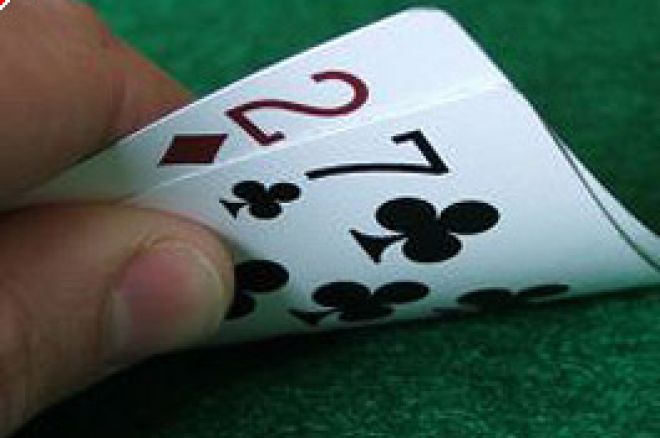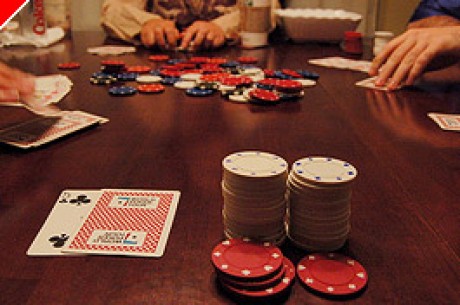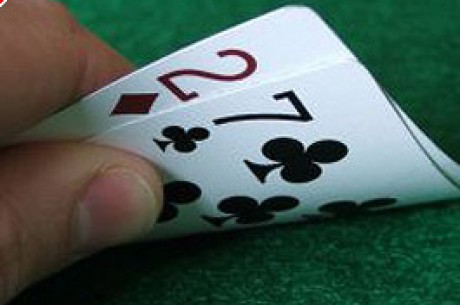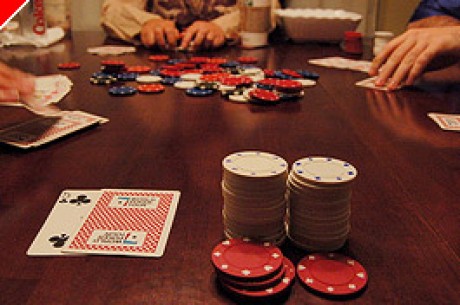The 'Other Games' of Poker: Stud 8 or better

Take a look at any of the typical mixed games offered online or at your local casino and you'll almost certainly find an acronym including the letter 'E.' That 'E' in H.O.R.S.E., H.O.S.E., and S.H.O.E. stands for eight-or-better stud, more commonly referred to as stud 8/b or stud hi-lo. With the rise in availability of mixed games both live and online, more and more hold'em players are giving them a go. However, more often than not, stud 8 will end up being their weakest game in the lineup simply from a lack of experience. To get started, stud 8 cash games are available around the clock on all of the major online poker sites (Poker Stars has limits as low as 4 cent-8 cent), and if you're lucky enough to live in Southern California, there are loose, juicy stud 8 games abound at the Commerce Casino.
Rules
Stud 8 is played in a two-tiered fixed limit structure with an ante instead of blinds. The ante is typically about 1/5 the size of a small bet. So, if you are playing in a $5-$10 game, each player will ante $1 at the start of the hand. Players are dealt two down cards and one upcard, called the "door card." The first round of betting is initiated by the low card on the board. That player must make a forced bet called the "bring-in," which is about 1/3 of a small bet. Or, they can choose to "complete" the bet and raise it up to the size of a full small bet. Once the first round of betting is complete, each player still in the hand receives another up-card called fourth street. Another round of betting proceeds with the high card now forced to initiate the action on this round (and all future rounds), though there is no longer a forced bet. Bets on fourth street are made at the smaller limit, unless a player is already showing a pair. A player with an open pair on fourth street will not only initiate the betting round, but he or she can choose to make a double bet, kicking the game from it's smaller limit to it's bigger limit one street early.
The bet sizes go up on the betting rounds after the fifth and sixth street upcards are dealt (if we're in a $3-$6 game, all the bets and raises are at the $6 limit now). The seventh and final card is dealt face down followed by another round of betting. The player with the best high hand wins half the pot and the player with the best low hand containing five cards under 8 wins the other half. If there is no qualifying low hand, the high hand takes the whole pot.
Basic Strategy/Starting Hands
Stud 8 or better is a game where you'll want to play tighter than usual. The good news is that the monetary swings are less severe in stud 8 than they are in stud high or in limit hold'em since it's a split-pot game. Patience and simple, straightforward play are rewarded. Bet or raise when you think you have the best of it. Check, call, or fold when you think you're behind. Stud 8 is not a place for crazy fancy plays.
Like in Omaha 8 or better, you must play to scoop the pot in stud 8/b, not just to win half of it. When deciding to play a starting hand, evaluate it from that perspective– how can these cards lead me to a scoop? The mother of all starting hands in stud 8/b are three suited low cards. If an ace is one of them, even better. Ah-2h-3h? Ad-3d-4d? 2s-3s-5s? You'll be raising with those. They give you the potential not only to make the best low, but to make flushes and straights as well. Rolled-up trips such as 7(7-7) are also a cause for celebration. Next down on the food chain are three low straight cards, such as 5-6-7, 4-5-6, or 3-4-5. With hands like this, you have a good number of outs to pick up either a low draw or a straight draw (or both) on fourth street and you'll be in good shape against big pairs that are sticking around in the hand for the high half of the pot. Other starting hands that are worth a look are three cards below an 8 with some sort of high feature going for it as well, such as the Ad (2c-7d). With a hand like this, you'll often have the best low draw to start as well as the chance to spike an ace and make a pair of aces for high.
Big pairs, such as K (K-8), while a powerful starting hand in stud high, can be a disaster in stud 8/b. If any of your opponents are showing an ace as their door card and come in for a raise, you should seriously think about folding right then and there. You may have the best hand right now, but your likelihood of scooping the pot with your bare pair of kings is very slim. More often than not, someone is going to be holding an ace and going for low in that pot with you and they could easily back into a pair of aces, or even aces up for high along the way. Meanwhile, you're sucked into calling big bets on the later streets and end up hemorrhaging money in the long run, especially when you end up catching two pair yourself and your kings-up loses to the aces-up. That's not to say you should always fold your kings or queens on third street. If you have a hand with a buried pair and the highest door card on board like K (J-J), you should go ahead and play it strong because even if your opponent has something like Q (T-Q) your raise will probably scare him off his hand.
Stud 8 can sometimes seem scary and complex, but it's really one of the most straightforward poker variants out there and well worth adding to your arsenal, especially if you're thinking about getting involved in mixed games or tournaments, where it will almost always be a component. Just remember to start small, not get too fancy, and play to scoop! You'll be dragging pots in no time.








